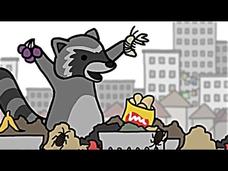Veritasium
Why Are 96,000,000 Black Balls on This Reservoir?
A Los Angeles reservoir is the largest ball pit on Earth. Learn the problem and solution of the water treatment plant in LA in a Veritasium video lesson. An unexpected chemical reaction created an issue in the treatment of water, and the...
Be Smart
1 Million Species Could Go Extinct… Here’s Why
The human carbon footprint may be larger than anyone thought. It is estimated that one million species are at risk of going extinct due to human impact on the environment. An installment from the large It's Okay to be Smart series...
PBS
The Croc That Ran on Hooves
A crocodile with hooves and razor-sharp teeth was really a thing—and there is proof. A video lesson from the PBS Eons series presents the fossil evidence and explores the reasons for the adaptations of the unique reptile. Scholars see a...
TED-Ed
The Lovable (and Lethal) Sea Lion
What lives in the ocean, has ears, walks on all fours, and can reach a top speed of 18 miles an hour? Why, the sea lion, of course! A cute, animated video introduces viewers to the majestic aquatic mammal.
Crash Course
Controlling the Environment: Crash Course History of Science #39
What would the world look like if we could control the weather? Historically, countries have attempted to do just that, but their intentions were not always good! The 39th lesson in a History of Science series describes science projects...
American Chemical Society
Why Flamingos Are Pink and Hardcore
They're not just pretty faces! Flamingos may look delicate, but they have adaptations that allow them to survive in areas most other organisms cannot. A video lesson in a larger ACS Reactions series describes how flamingos survive in...
Howard Hughes Medical Institute
Anole Lizards: An Example of Speciation
What happens to a species when members become separated by changes in their environment? Present young biologists with the ultimate example species—the anole lizard. A brief video describes the origins of the multitude of anole species...
Bozeman Science
LS3B - Variation of Traits
Make sure your unit on trait variation causes a sensation! Take an in-depth look at standard LS3B, an important component of the Next Generation Science Standards. The narrator discusses methods of delivering the standard to younger...
Deep Look
Pygmy Seahorses: Masters of Camouflage
Watch as pygmy seahorses become one with their environment. The life of a pygmy seahorse begins and ends on a branch of coral. An interesting video lesson explores how camouflage protects this delicate species and how they adapt when...
MinuteEarth
Why Do Some Species Thrive in Cities?
How do wild animals adapt to our urban expansion? An interesting video lesson describes different adaptation strategies of common species. The narrator includes a discussion of the changes in DNA.
Bozeman Science
Ecological Succession
Never trust a tree, they always look shady. The video explains both primary and secondary succession. It uses examples of volcanic activity, fires, and human disturbances. It is the seventh in an 18-part series.
Crash Course Kids
How to Get Resources - Picky Pineapples
How do we survive if the resources we need are not available? This is the focus of a video that explains how humans adapt and transform to get the resources they need. An investigation of how Las Vegas has adapted to using a...
Crash Course Kids
Living Things Change
What happens to organisms when the environment around them changes? This is the focus of a video that describes how living things must adapt to their ever-changing environment.












